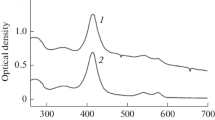Summary
The assumption that the red blood cell can be used as a model for ouabain receptor regulation in heart muscle has been tested using isolated tissues from humans, guinea pigs, and chickens. The following results were obtained:
-
1.
The affinity of the ouabain receptor was similar in both human erythrocytes and right atrial appendage, but the density of binding sites was much lower on the erythrocytes. There was no correlation between the binding capacity in both tissues.
-
2.
Ouabain receptor occupation was closely correlated with inhibition of Na+/K+-transport in human erythrocytes and chick heart nonmuscle cells in culture. In contrast, in chick heart muscle cells, an occupation of 40% of the receptors decreased the Na+/K+-transport rate by only 10%.
-
3.
In hypokalemia, the ouabain binding capacity was increased in human and guinea pig erythrocytes but not in guinea pig heart muscle. Such increases were seen in chick heart nonmuscle cells in moderate hypokalemia but in heart muscle cells only after severe hypokalemia. Incubation of chick heart muscle cells in toxic but not in “therapeutic” ouabain concentrations increased the number of ouabain receptors. Increases in receptor number attenuated the positive inotropic and toxic actions of ouabain.
These variations between ouabain receptor regulation in red blood cells and heart muscle of several species may be attributable to the lack of a “sodium pump reserve” in erythrocytes and heart nonmuscle cells. Such variations indicate that the human erythrocyte is not a suitable model for the ouabain receptor in the human heart.
Similar content being viewed by others
Abbreviations
- KL :
-
dissociation constant
- (Na++K+)-ATPase:
-
sodium and potassium activated adenosine triphosphatase (EC 3.6.1.3)
References
Akera T, Brody TM (1978) The role of Na+,K+-ATPase in inotropic action of digitalis. Pharmacol Rev 29:187–220
Brown L, Wagner G, Hug E, Erdmann E (1986) Ouabain binding and inotropy in acute potassium depletion in guinea pigs. Cardiovasc Res XX:286–293
Brown L, Werdan K, Erdmann E (1983) Consequences of specific3H-oubain binding to guinea pig left atria and cardiac cell membranes. Biochem Pharmacol 32:423–435
Cumberbatch M, Zareian K, Davidson C, Morgan DB, Swaminathan R (1981) The early and late effects of digoxin treatment on the sodium transport, sodium content and Na+,K+-ATPase of erythrocytes. Br J Clin Pharmacol 11:565–570
Erdmann E (1981) Influence of cardiac glycosides on their receptor. In: K Greeff (ed) Handbook of experimental pharmacology, 56/I, pp 337–380, Springer, Berlin Heidelberg
Erdmann E (1982) Binding studies with3H-ouabain to red cell membranes. In: JC Ellory, JD Young (eds) Red cell membranes — a methodological approach. Academic, London New York San Francisco pp 251–262
Erdmann E, Brown L (1983) The cardiac glycoside-receptor system in the human heart. Eur Heart J 4 [Suppl A]:61–65
Erdmann E, Werdan K, Krawietz W (1984) Influence of digitalis and diuretics on ouabain binding sites on human erythrocytes. Klin Wochenschr 62:87–92
Ford AR, Aronson JK, Grahame-Smith DG, Carver JG (1979) The acute changes seen in cardiac glycoside receptor sites,86Rb-uptake and intracellular sodium concentrations in the erythrocytes of patients during the early phases of digoxin therapy are not found during chronic therapy: pharmacological and therapeutic implications for chronic digoxin therapy. Br J Clin Pharmacol 8:135–142
Kim D, Barry WH, Smith TW (1984) Kinetics of ouabain binding and changes in cellular sodium content,42K+-transport and contractile state during ouabain exposure in cultured chick heart cells. J Pharmacol Exp Ther 231:326–333
Kim D, Marsh JD, Barry WH, Smith TW (1984) Effects of growth in low potassium medium or ouabain on membrane Na,K-ATPase, cation transport and contractility in cultured chick heart cells. Circ Res 55:39–48
Langer GA (1983) The “sodium pump lag” revisited. J Mol Cell Cardiol 15:647–651
Malini PL, Strocchi E, Marata AM, Ambrosioni E (1984) Digitalis “receptors” during chronic digoxin treatment. Clin Exp Pharmacol Physiol 11:285–289
Repke K, Portius HJ (1963) Über die Identität der Ionenpumpen-ATPase in der Zellmembran des Herzmuskels mit einem Digitalis-Rezeptor-Enzym. Experientia 19:452–458
Scatchard G (1949) The attraction of proteins for small molecules. Ann NY Acad Sci 51:660–672
Werdan K, Bauriedel G, Bozsik M, Krawietz W, Erdmann E (1980) Effects of vanadate in cultured rat heart muscle cells. Vanadate transport, intracellular binding and vanadate-induced changes in beating and in active cation flux. Biochim Biophys Acta 597:364–383
Werdan K, Reithmann C, Erdmann E (1985) Cardiac glycoside tolerance in cultured chicken heart muscle cells — a dose-dependent phenomenon. Klin Wochenschr 63:1253–1264
Werdan K, Reithmann C, Krawietz W, Erdmann E (1984) Chronic exposure to toxic but not to “therapeutic” concentrations of ouabain increases cardiac glycoside receptors in cardiac muscle cells from chicken embryos. Biochem Pharmacol 33:2337–2340
Werdan K, Reithmann C, Schneider G, Erdmann E (1985) Modulation of cardiac glycoside sensitivity of beating heart muscle cells in culture. In: Ellory JC, Glynn IM (eds) The sodium pump, Proceedings of the fourth international conference on Na, K-ATPase, Cambridge UK, pp 679–683
Werdan K, Schneider G, Krawietz W, Erdmann E (1984) Chronic exposure to low K+ increases cardiac glycoside receptors in cultured cardiac cells: different responses of muscle and nonmuscle cells from chicken embryos. Biochem Pharmacol 33:1161–1164
Werdan K, Wagenknecht B, Zwissler B, Brown L, Krawietz W, Erdmann E (1984) Cardiac glycoside receptors in cultured heart cells. I. Characterization of one single class of high affinity receptors in heart muscle cells from chick embryos. Biochem Pharmacol 33:55–70
Werdan K, Zwissler B, Wagenknecht B, Krawietz W, Erdmann E (1983) Quantitative correlation of cardiac glycoside binding to its receptor and inhibition of the sodium pump in chicken heart cells in culture. Biochem Pharmacol 32:757–760
Winegrad S, Shanes AM (1962) Calcium flux and contractility in guinea pigs. J Gen Physiol 45:371–394
Author information
Authors and Affiliations
Rights and permissions
About this article
Cite this article
Brown, L., Werdan, K. & Erdmann, E. The red blood cell: A model for ouabain receptor regulation in the heart?. Klin Wochenschr 64, 786–792 (1986). https://doi.org/10.1007/BF01732188
Received:
Revised:
Accepted:
Issue Date:
DOI: https://doi.org/10.1007/BF01732188




